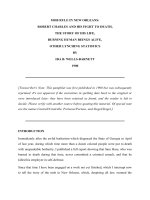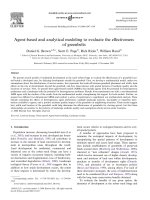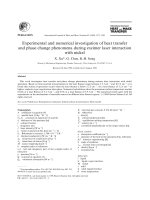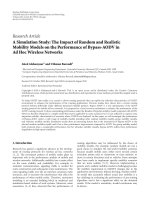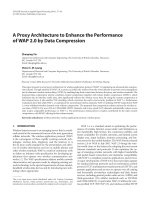Experimental and numerical investigation to evaluate the performance of triangular finned tube heat exchanger
Bạn đang xem bản rút gọn của tài liệu. Xem và tải ngay bản đầy đủ của tài liệu tại đây (1.63 MB, 14 trang )
INTERNATIONAL JOURNAL OF
ENERGY AND ENVIRONMENT
Volume 6, Issue 6, 2015 pp.553-566
Journal homepage: www.IJEE.IEEFoundation.org
Experimental and numerical investigation to evaluate the
performance of triangular finned tube heat exchanger
Vinous M. Hameed, Bashar Muslem Essa
Mechanical Engineering Department, College of Engineering, Al-Nahrain University, Baghdad, Iraq.
Abstract
Experimental and numerical investigation has been performed in this work to evaluate the performance
for triangular finned tube heat exchanger. Experimental work included designing and manufacturing of
shaped triangular fins from copper material of (10mm) length, (10mm) height, (1mm) thickness, (22
mm) distance between every two fins shaped and (15mm) pitch between each two of fins which are
install on the straight copper tube of (2m) length having (20mm) inner diameter and (22mm) outer
diameter. The inner tube is inserted inside the Perspex tube of (54mm) inner diameter and (60mm) outer
diameter. Cold Air and hot water are used as working fluids in the shell side and tube side, respectively.
Air at various mass flow rates (0.001875 to 0.003133) kg/sec flows through annuli and water at
Reynold's numbers ranging from (10376.9 to 23348.03) flows through the inner tube. Performance of
(smooth and finned) tube heat exchanger was investigated experimentally. Experimental results showed
that the enhancement of heat dissipation for triangular finned tube is (3.252 to4.502) times than that of
smooth tube respectively. Numerical simulation has been carried out on present heat exchanger to
analyze flow field and heat transfer using COMSOL computational fluid dynamic (CFD) package model.
The comparison between experimental work and numerical results showed good agreement.
Copyright © 2015 International Energy and Environment Foundation - All rights reserved.
Keywords: Heat exchanger; Finned tube; COMSOL package.
1. Introduction
Materials and Energy saving considerations as well as economic incentives have lead up to an effort to
produce more efficient heat exchange equipment. public thermal hydraulic goals are to decrease the size
of a heat exchanger desired for a specified heat duty, to improve the capacity of an existing heat
exchangers and to decrease the approach temperature difference for the process streams or to decrease
the pumping power. The study of improved heat transfer rendering is denote to as heat transfer
enhancement, intensification, or augmentation. In common, this means an increment in heat transfer
coefficient [1]. One of the important kinds of double pipe concentric tube is Water to Air heat exchanger.
This type of heat exchanger has various application such as: apartment Buildings and Condominiums,
Residential Heating, Hybrid Systems, Air Conditioning, Dehumidification. S. Angela Ourivio Nieckele
et al. [2] performed study to investigate the mean heat transfer coefficients and friction factors for
turbulent flow through annular channels with pin fins attached to the inside wall of the annulus. The
measurements were arrangement by averages of a double-pipe heat exchanger. The number of pins in a
same cross-section (transversal row) was 8, while the number of transversal rows was 70, totaling 560
pins. The working fluids were air, flowing in the annular duct, and water through the internal circular
ISSN 2076-2895 (Print), ISSN 2076-2909 (Online) ©2015 International Energy & Environment Foundation. All rights reserved.
554
International Journal of Energy and Environment (IJEE), Volume 6, Issue 6, 2015, pp.553-566
tube. The range of the Reynolds number, for the air-side flow, was variation from (13,000 to 80,000).
The experiments were performed in an open-loop air flow circuit. The warm fluid (water) operates in a
closed-loop circuit and its mass flow rate is controlled by the valve. The water circuit is designed in such
way that the heat exchanger works in counter flow mode. The Experiments results showed the for the
same Reynolds numbers, the Nusselt numbers for the pinned annulus are roughly 200% more than those
for the smooth annular duct. Yu et al. [3] performed to compute the heat transfer and pressure drop
characteristics of tubes with internal wave-like longitudinal fins. They conducted two cases for this work
were carefully examined, using air as a working fluid. For the tube of type A, since the inner channel of
the insertion is not blocked, its flow cross-section area only differs mildly from that without the insertion.
While for the tube of type B the cross-section of the inner tube is totally blocked. The test tube is
arranged in such a way that its axis is in a horizontal plane. The test tube and fins are made from copper.
The wave-like fins are within the annulus and span its full width. There are total 20 waves. The outer
tube was electrically heated. Pressure taps were no uniformly distributed in 13 cross-sections along the
test tube axis. The temperatures of the test tube surface were measured by 39 copper-constantan
thermocouples. The range of Reynold's number was varied from 9*102 to 3.5*103. Results showed that
the wave-like fins enhance heat transfer significantly with the blocked case by 36% higher than that of
unblocked tube. Mohsen Sheikholeslami etc [4] investigated flow and heat transfer in a horizontal
annular tube double pipe heat exchanger is experimentally. The inside tube is made from copper, while
the outer tube is made from PVC. The temperature were measured with Stainless steel thermocouples.
Pressure losses were determined by using U-manometers that were stuffed with water for the air side.
The flow is designed as according to countercurrent flow and turbulent flow. Warm water was passed
through the inside pipe, while cold air was flowing through the annulus duct. Water at various volumetric
flow rates in the range of from 120 to 200 (Lit/h) flows through the inside tube and in the temperature of
water range from 70 to 90 °C. The experimental Results depict that Nusselt number in water side
increments with increments of temperature of the water and flow rate of water while opposite trend is
observed for Nusselt number in air side. Friction factor increments with increment of inlet temperature
and inlet velocity of water. Dong et al. [5] performed study to accomplish the influence of cribriform
annular finned–tube on the convective heat transfer of annular finned–tube heat exchanger. The
convective heat transfer coefficient was increment by 3.55% and 3.31% and increment in pressure drop
by 0.68% and 2.08% for two- hole and four -hole cases respectively. Iqbal et al. [6] investigated of the
optimal longitudinal triangular fins (initial shape) close fitting to the outer surface of the inner pipe
enclosed. Within a laminar, incompressible and fully- developed flow in the shell of two concentric
circular pipes at regular heat flux. The fins are straight, non-porous, regularly distributed about the
periphery of the inside pipe and are assumed to be made up of highly conductive material. The fin profile
is showed by Piecewise Cubic Hermite Interpolating Polynomial (PCHIP). The results depict that the
optimal shape is strongly dependent on the ratio of radii, the number of fins, and the number of control
points and the characteristic length. The increment in the Nusselt number up to 138%, 263% and 312%
over the traditional fins of trapezoidal, parabolic and triangular shapes for equipollent diameter however
212%, 90% and 59% respectively for hydraulic diameter. Mayank Bhola et al. [7] investigated modeled
and simulated for annular tube heat exchanger with and minus insert. Design process for heat exchanger
and insert has been carried out in SOLIDWORKS, fluid domain is formed in ANSYS workbench for
steel. Inlet temperature of warm water and cold air are (60 - 26) °C respectively. CFD computations were
done for three various mass flow rate of air (0.0079, 0.018, and 0.036) kg/s and water (0.0216, 0.36091,
and 0.6767) kg/s for both counter flow and parallel flow condition. The profile tape of insert is
rectangular insert. The results have illustrative a good acceptable. The inside convective heat transfer
coefficient for rectangular insert of this type is roughly 25% higher than for smooth tube. Counter flow
configuration is high efficient than parallel flow. And depict increment in heat transfer coefficient of
roughly 27%. Shuai and Chang [8]. Performed three–dimensional numerical simulation on integral pin–
fin tube heat exchanger using fluent software. They verified that the fluent software on integral pin–fin
tube numerical simulation method is feasible. Fluent software was proven to be feasible for numerical
simulation on integral pin–fin tube and be effective tools to design and develop heat exchange tubes.
Mon and Gross [9] investigated a numerical analysis of pressure drop and heat transfer characteristics on
the air side of the circular –finned tube heat exchangers. They studied the influences of fin spacing on
(4–row) circular –finned tube parcels in staggered and in–line configurations. The results detection a
paramount point of opinion for the flow and the local heat transfer characteristics of the circular –finned
tube bundles and the boundary layer improvement on the fin and tube surfaces according to the fin
ISSN 2076-2895 (Print), ISSN 2076-2909 (Online) ©2015 International Energy & Environment Foundation. All rights reserved.
International Journal of Energy and Environment (IJEE), Volume 6, Issue 6, 2015, pp.553-566
555
spacing to height ratio. The heat transfer coefficient of the staggered arrangements was increment with
height ratio up to (0.32) and then preserved constant. For in–line configuration, the heat transfer
coefficient increment over the whole realization range and the pressure drop was reduced for both arrays
when height ratio increment. Good agreement was noted of heat transfer with experimental correlations.
Mir et al. [10] carried out numerical simulation of studying laminar, forced convection heat transfer in
the finned annulus for the case of fully- developed incompressible flow. The simulation was
corresponding to thermal boundary condition of regular heat input per unit axial length with peripherally
regular temperature at any cross section. They used boundary fitted curvilinear coordinates to overcome
the singularities presented by fin tip. In the solution domain, different heat transfer and fluid flow were
accomplished for a range of values of the ratio of radii of inside and outer tubes, fin height and number
of fins. The results depict a good agreement comparison with the literature results.
2. Numerical simulation
Numerical simulation by using COMSOL (5.0) computational fluid dynamic (CFD) package model has
been conducted for performing numerical simulation across the heat exchanger using three–dimensional
model. The solution of conservation continuity, momentum and energy equations are used to analyze the
flow field inside the heat exchanger. A comparison of heat transfer for (smooth, triangular) finned tube
heat exchanger is carried out. AutoCAD is used to draw the geometries of this work with and without
consist triangular finned tube heat exchanger with inlet and outlet portions, the outside flow is confined
by insulating tube having inlet and outlet portions as shown in Figures 1 and 2.
Figure 1. CFD domain of smooth tube heat exchanger
Figure 2. CFD domain of triangular finned tube heat exchanger
ISSN 2076-2895 (Print), ISSN 2076-2909 (Online) ©2015 International Energy & Environment Foundation. All rights reserved.
556
International Journal of Energy and Environment (IJEE), Volume 6, Issue 6, 2015, pp.553-566
3. Governing equations
The governing differential equation for the fluid flow is given by Continuity equation or mass
conservation equation, Navier Stokes equation or momentum conservation equation and energy
conservation equation [11].
3.1 Continuity equation
(1)
where (u, v, w) Velocity component in x, y, z directions
3.2 Navier Stokes equation
(2a)
(2b)
(2c)
where ρ is the density( Kg/m3), μ is the dynamic viscosity (Kg/ms), ∇ is the vector differential operator
3.3 Energy equation
(3)
where Cp is the specific heat (J/kg-K), T is the temperature (K),Φ is the Rayleigh dissipation factor
(4)
4. Boundary conditions
Velocity inlet was specified for inner and annuli sides during this study. On the other hand the
temperature inlet of the inner tube is (70) °C while in annuli is (30) °C.
5. Mesh generation
Unstructured mesh is used in the present study to discretize the computational domain into a finite
number of control volumes by using the finite–volume scheme. Structured mesh is ruled out because it is
favorable for easy cases and it becomes insufficient and time consumed for complicated geometries. The
model was meshed by using COMSOL (5.0) computational fluid dynamic (CFD) package. The
refinement and generation of mesh system are very crucial to predict the heat transfer in sophisticated
geometries. Thus both the density and distribution of the mesh lines play distinct roles for accuracy.
Complete mesh consists of 39435 domain elements, 5588 boundary elements, and 400 edge elements for
plain tube and mesh consists of 165268 domain elements, 14788 boundary elements, and 2857 edge
elements for triangular finned tube as shown in Figures 3 and 4.
ISSN 2076-2895 (Print), ISSN 2076-2909 (Online) ©2015 International Energy & Environment Foundation. All rights reserved.
International Journal of Energy and Environment (IJEE), Volume 6, Issue 6, 2015, pp.553-566
557
Figure 3. CFD meshing of smooth tube heat exchanger
Figure 4. CFD meshing of finned tube heat exchanger
6. Experimental test rig
Figures 5 and 6 show the schematic diagram and photograph of test rig of test section. Test rig consists
of test section, air and water supply system, measuring devices and supplements. Various kinds of
measuring devices have been used such as digital anemometer, temperature recorder, water flow meter,
thermocouples and temperature probes. The test section contains two parts, the first consists annuli tube
has been manufactured from Perspex material of (54mm) inner diameter, (2m) length and (3mm)
thickness. The second part is an internal copper tube without or with triangular copper fins. The smooth
copper tube has (2m) long and (0.02m, 0.022m) inner and outer diameter respectively. Many triangular
fins are manufactured from copper, they are install to the external surface of tube by technique having
(10mm) length, (10mm) height, (1mm) thickness and (15mm) distance between every pair and (22mm)
pitch between each two pairs of fins. A water pump is used for pumping the water in pipes through the
water cycle and test section. It has (30 liter/minute) volumetric flow rate and centrifugal blower is
employed to provide air for the test section through pipe with the power of 0.75 kW. The flow rates of
the water were adjusted with valves and measured with rotameter. The experimental work was repeated
for both countercurrent flow modes at various Reynolds numbers of water and air.
7. Validation
The comparison for Nusselt number, the experimental data are in good agreement with existing
correlations, which are Dittus–Boelter correlation. It is noted that the Nusselt number differs by up 7%
ISSN 2076-2895 (Print), ISSN 2076-2909 (Online) ©2015 International Energy & Environment Foundation. All rights reserved.
558
International Journal of Energy and Environment (IJEE), Volume 6, Issue 6, 2015, pp.553-566
from the Dittus– Boelter correlation as show in Table 1. In addition, the experimental results of the
present study are correlated with Nusselt number as follow,
For 2300
(5)
where Nu is the Nusselt number, Re is the Reynolds number and Pr is the Prandial number
Figure 5. Schematic of test rig
Figure 6. Photograph of test rig
(6)
where Q is the heat dissipation (w), m ̇ is the mass flow rate (kg/sec), Cp is the Specific heat and T is the
temperature (°C). The Subscripts o, i and h is Indicates outer, inner and hot respectively.
ISSN 2076-2895 (Print), ISSN 2076-2909 (Online) ©2015 International Energy & Environment Foundation. All rights reserved.
International Journal of Energy and Environment (IJEE), Volume 6, Issue 6, 2015, pp.553-566
559
(7)
and
(8)
where ΔTLMTD is the log mean temperature difference (°C). Figure 7 shows the distribution of
temperatures in counter flow heat exchanger.
Table 1. Experimental, analytical and CFD results for different Reynolds number
Re
10376.9
12971.127
15565.35
18159.57
20753.8
23348.03
Experimental Nu
45.377
50.276
62.947
70.562
79.989
89.999
Analytical Nu
49.662
59.547
68.173
77.843
86.497
95.437
CFD Nu
46.086
51.179
63.734
71.895
81.247
92.981
Figure 7. Distribution of temperatures in counter flow heat exchanger
(9)
where hi is the heat transfer coefficient (W/m^2 K) of the tube, A is tube surface area (m^2).
(10)
where D is tube diameter (m) and k is thermal conductivity (W/m K).
8. Results and discussions
Figure 8 shows the effect of different water Reynold's number on the inner Nusselt's number. It can be
seen from these figures that water side Nusselt's number increases due to turbulence generated by
increasing of water Reynold's number indicating maximum increase of (67%). Figure 9 show the
variation of the air side temperature difference with the air mass flow rate for smooth and triangular
ISSN 2076-2895 (Print), ISSN 2076-2909 (Online) ©2015 International Energy & Environment Foundation. All rights reserved.
560
International Journal of Energy and Environment (IJEE), Volume 6, Issue 6, 2015, pp.553-566
finned tube. The air temperature difference decreases by (5%) as a result of increase air mass flow rate.
The air side temperature difference in finned tube is larger by (25%) than that of smooth tube due to
enhancement by increasing the surface area. Figure 10 illustrate the variation of the water side
temperature difference with the water Reynold's number for smooth and triangular finned tube. The
water side temperature difference tends to decrease (20%) by increasing water Reynold's number. Figure
11 disclose the relation between different water Reynold's number and heat dissipation for smooth and
triangular finned tube. It can be seen from Figure 11 that heat dissipation of finned tube is higher than
that of smooth tube due to increase of surface area. The enhancement of heat dissipation for triangular
finned tube is (3.252 to4.502) times than that of smooth tube respectively. Figure 12 show the relation
between different air Reynold's number and effectiveness for smooth and triangular finned tube The
figure show that the effectiveness tends to decrease with increasing Reynolds number, which the air
effectiveness decreases by (5%) as a result of the increase in Air Reynold's. The air side effectiveness in
finned tube is larger by 18% than that of smooth tube. This because that the effectiveness decease with
increasing the hot water mass flow rate. Experimental results of test rig are validated in this study by
numerical simulation produced by COMSOL (5.0) computational fluid dynamic (CFD) package model
as shown in Figure 13. In this figure, the Nusselt number of inner tube has been illustrated with
Reynold's number. Good agreement is observed with 4% difference between experimental and numerical
results. Figures14 to 17 shows the temperature and velocity contours of smooth tube heat exchanger at
different axial distances. It can be noted that the maximum air and water temperatures appears at Z/d = 1
while the minimum temperatures appears at Z/d = 9. It can be seen also when observing Z/d = middle,
that changing water Reynold's number will not have a significant effect on air side. It seems that the air
in annuli has the main reason for this behavior. This is because air thermal conductivity is small.
Velocity contours in these figures at air side show that air inlet velocity distribution at Z/d = 2, 3, 4 are
uniform but at Z/d=1,5are irregular because effect the inlet and outlet zone of air. It will also tend to
decrease inside heat exchanger near the walls of inner and outer tubes. Velocity contours in these figures
at water side show that the water velocity at the center increases while the velocity gradient near the wall
decreases with increasing axial distance. Figures 18 to 21 reveal the temperature and velocity contours of
triangular finned tube heat exchanger for specified water Reynold's numbers at various axial distances
ratio. Results showed a significant heat transfer augmentation in heat exchanger for air and water sides.
The effect of adopting fins on heat transfer enhancement is apparent in both sides. Heat transfer
enhancement behavior is clear when increasing water Reynold's number. Increasing mass flow rate of air
tends to increase water side temperature difference along axial distance and decreasing in air side
temperature difference. Velocity contours in these figures reveal that the air velocity increases at the
center. The effect of wall on decreasing the velocity in air and water sides is apparent in these figures.
Figure 8. Variation of water Reynold's number with water side Nusselt's number
ISSN 2076-2895 (Print), ISSN 2076-2909 (Online) ©2015 International Energy & Environment Foundation. All rights reserved.
International Journal of Energy and Environment (IJEE), Volume 6, Issue 6, 2015, pp.553-566
561
Figure 9. Effect of air mass flow rate on air temperature difference
Figure 10. Effect of water Reynold's number on water temperature
Figure 11. Effect of water Reynolds number on heat dissipation
ISSN 2076-2895 (Print), ISSN 2076-2909 (Online) ©2015 International Energy & Environment Foundation. All rights reserved.
562
International Journal of Energy and Environment (IJEE), Volume 6, Issue 6, 2015, pp.553-566
Figure 12. Variation of heat exchanger effectiveness with air Reynolds number
Figure 13. Comparisons of CFD and experimental data and empirical correlations of the plain tube for Nu
Z/d = 1
Z/d = 9
Figure 14. Temperature contours at various axial distances for smooth tube heat exchanger
ISSN 2076-2895 (Print), ISSN 2076-2909 (Online) ©2015 International Energy & Environment Foundation. All rights reserved.
International Journal of Energy and Environment (IJEE), Volume 6, Issue 6, 2015, pp.553-566
563
Z/d = 1
Z/d = 5
Figure 15. Velocity contours at various axial distances for smooth tube heat exchanger
Figure 16. Velocity contours of air side for smooth tube heat exchanger
Figure 17. Velocity contours of water side for smooth tube heat exchanger
ISSN 2076-2895 (Print), ISSN 2076-2909 (Online) ©2015 International Energy & Environment Foundation. All rights reserved.
564
International Journal of Energy and Environment (IJEE), Volume 6, Issue 6, 2015, pp.553-566
Figure 18. Temperature contours at various axial distances for triangular finned tube heat exchanger
Figure 19. Velocity contours of air side for triangular finned tube heat exchanger
Figure 20. Velocity contours of water side for triangular finned tube heat exchanger
ISSN 2076-2895 (Print), ISSN 2076-2909 (Online) ©2015 International Energy & Environment Foundation. All rights reserved.
International Journal of Energy and Environment (IJEE), Volume 6, Issue 6, 2015, pp.553-566
565
Figure 21. Temperature contours (distribution) at all zone for triangular finned tube heat exchanger
9. Conclusion
Air side temperature difference is directly proportional with the water Reynold's number and decreased
by (5%) with increasing the air mass flow rate. Water side temperature difference is directly proportional
to the air mass flow rate and decreased by (20%) with increasing the water Reynold's number. Results of
numerical simulation showed that adding fins would enhance heat dissipation through heat exchanger. It
is noted that heat transfer behavior increases within present model as air mass flow rates and water
Reynold's numbers increases. Heat transfer enhancement by adding triangular fins to outer surface tube
has been found during numerical simulation. Numerical simulation by using COMSOL (5.0)
computational fluid dynamic (CFD) package model. Is successful for predicting both heat transfer and
fluid flow in the present heat exchanger. The heat transfer augmentation is apparent when adopting fins
on outer surface of inner tube in present heat exchanger. This enhancement appears clearly in heat
dissipation indicating (3.252 to4.502) times than that of smooth tube. Significant enhancement has been
found in heat exchanger effectiveness by adopting fins on outer surface of inner tube.
Acknowledgements
The author would like to thank the Department of Mechanical Engineering, Al-Nahrain University, for
supporting testing facilities. The researcher would like to express great appreciation to Dr. Maher AlBaghdadi for providing remarkable support for this study.
References
[1] Arthur E. Bergles. The Imperative to Enhance Heat Transfer. Department of Mechanical
Engineering, Aeronautical Engineering and Mechanics Rensselaer Polytechnic Institute pp.13-29,
1999.
[2] Angela Ourivio Nieckele, Francisco Eduardo Mourão Saboya, "Turbulent Heat Transfer and
Pressure Drop in Pinned Annular Regions", J. Braz. Soc. Mech. Sci. vol.22 n.1 Rio de Janeiro
2000.
[3] B. Yu, J. H. Nie, Q. W. Wang, W. Q. Tao," Experimental study on the pressure drop and heat
transfer characteristics of tubes with internal wave-like longitudinal fins", Heat and Mass Transfer
35 (1999) 65 ± 73 Ó Springer-Verlag 1999.
[4] M. Sheikholeslami, M. Jafaryar, F. Farkhadnia, D.D. Ganji, M. Gorji-Bandpy, "Thermal
management of double pipe air to water heat exchanger", Energy and Buildings
(2014),enbuild.2014.11.076.
[5] Dong H. Lee, Jin M. Jung, Jong H. Ha, Young I. Cho, ″Improvement of Heat Transfer with
Perforated Circular Holes in Finned Tubes of Air Cooled Heat Exchanger″, International
Communications in Heat and Mass Transfer, Vol.39, pp.161–166, 2012.
[6] Z. Iqbal*, K.S. Syed, M. Ishaq, "Optimal fin shape in finned double pipe with fully developed
laminar flow", Centre for Advanced Studies in Pure and Applied Mathematics (CASPAM),
ISSN 2076-2895 (Print), ISSN 2076-2909 (Online) ©2015 International Energy & Environment Foundation. All rights reserved.
566
International Journal of Energy and Environment (IJEE), Volume 6, Issue 6, 2015, pp.553-566
Bahauddin Zakariya University, Multan 60800, Pakistan, Applied Thermal Engineering 51 (2013)
1202e1223.
[7] Mayank Bhola, Vinod Kumar, Dr. Satyendra Singh," Heat Transfer Enhancement in Concentric
Tube Heat Exchanger in ANSYS FLUENT", International Journal of Engineering Research &
Technology (IJERT) ISSN: 2278-0181 IJERTV4IS040092 (This work is licensed under a Creative
Commons Attribution 4.0 International License.) Vol. 4 Issue 04, April-2015.
[8] Shuai Shi, Chang–qi Yan, ″Numerical Study of Heat Transfer and Pressure Drop of Integral Pin–
Fin Tubes″, Vol.978-1, pp.4244- 6255-1/11, 2011.
[9] Mon M. S. and Gross U., ″Numerical Study of Fin–Spacing Effects in Annular–Finned Tube Heat
Exchangers″, International Journal of Heat and Mass Transfer, Vol.47, pp.1953–1964, 2004.
[10] Mir N. A., Syed K. S. and Mazhar Iqbal, ″Numerical Solution of Fluid Flow and Heat Transfer in
the Finned Double Pipe″, Journal of Research (Science), Bahauddin Zakariya University, Multan,
Pakistan, Vol.15, No.3, pp.253-262, 2004.
[11] Lars Davidson, ″An Introduction to Turbulence Models″, Department of Thermo and Fluid
Dynamics, Chalmers University of Technology, Sweden, 2009.
Vinous Majeed Hameed Al-Temimi Asst. Prof. at Mechanical Engineering Department, College of
Engineering, Al-Nahrain University, Ph.D. in Chemical Engineering College of Engineering, AlNahrain University, Iraq. (2004). M.Sc. in Chemical Engineering College of Engineering, Al-Nahrain
University, Iraq. (1999). B.Sc. in Chemical Engineering College of Engineering, Al-Nahrain University,
Iraq. (1996). Academic experience: Three chemical engineering M.Sc. students and two mechanical
engineering M.Sc. students. Specialization: Thermodynamics, heat transfer, solar energy, refrigeration
and power cycles, enhanced heat exchangers. Seven published papers and a Fulbright scholar which is a
grant from the US embassy to Delaware University at 2014. Rewards: Certificate of appreciation from
the prime minister for the project of the graduation student which entitled " solar parabola mirror for
power generation" 2013". Certificate of appreciation from the president of Al-Nahrain university for the final year project at
Rabee Al-Nahrain Festival which entitled " solar parabola mirror for power generation" 2013. Certificate of appreciation from
the president of AlNahrain University for getting the second position on the graduation students at 1996; and President Saddam
award for competition between the graduation chemical engineering students at 1995/1996.
E-mail address:
Bashar Muslem Essa Researcher in Thermal Engineering, Department of Mechanical Engineering, AlNahrain University, Iraq. B.Sc. In Mechanical Engineering, College of Engineering, University of Kufa,
Iraq, 2013. He is a MSc student at the mechanical engineering department in Al-Nahrain university.
E-mail address:
ISSN 2076-2895 (Print), ISSN 2076-2909 (Online) ©2015 International Energy & Environment Foundation. All rights reserved.

